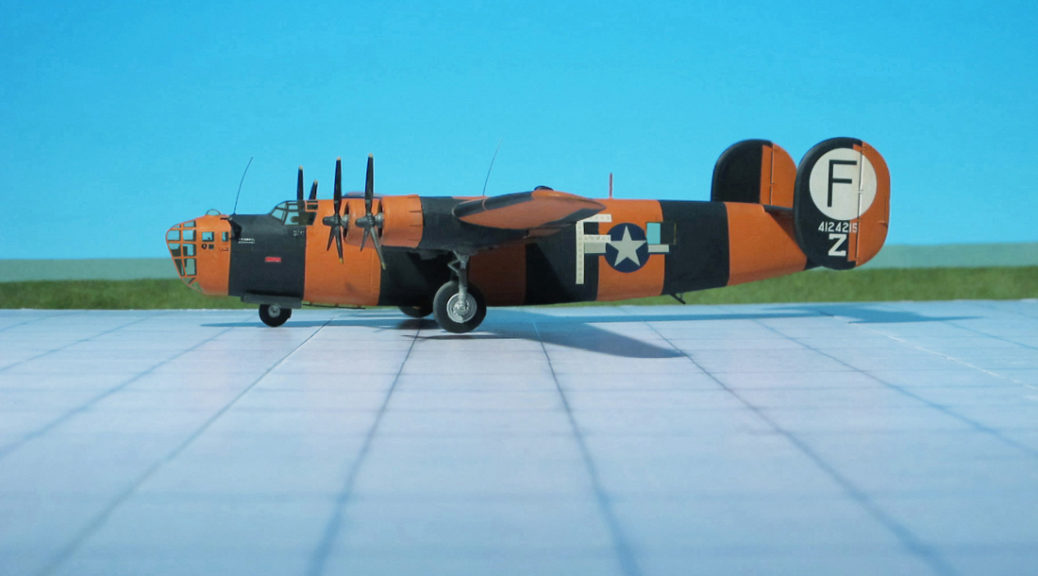TYPE: Heavy bomber, Assembly ship
ACCOMMODATION: Crew of four
POWER PLANT: Four Pratt & Whitney R-1830-43 Twin Wasp radial engines, rated at 1,200 hp each
PERFORMANCE: 303 mph at 25,000 ft
COMMENT: The Consolidated B-24 Liberator was an American heavy bomber, designed by Consolidated Aircraft of San Diego, California. It was known within the company as the Model 32, and some initial production aircraft were laid down as export models designated as various LB-30s, in the Land Bomber design category.
The B-24 was used extensively in WW II. It served in every branch of the American armed forces as well as several Allied air forces and navies. It saw use in every theater of operations. Along with the Boeing B-17 Flying Fortress, the B-24 was the mainstay of the US strategic bombing campaign in the Western European theater. Due to its range, it proved useful in bombing operations in the Pacific Area, including the bombing of Japan. Long-range anti-submarine Liberators played an instrumental role in closing the Mid-Atlantic gap in the Battle oft he Atlantic.
The Consolidated B-24D Liberator was the first mass-produced series. The B-24D was the Liberator III in British service. It entered US service in early 1942. It had turbocharged engines and increased fuel capacity. Three more 12.7 mm machine guns brought the defensive armament up to 10 machine guns. At 27,000 kg (29.76 short tons) maximum takeoff weight, it was one of the heaviest aircraft in the world.
First model produced on a large scale; ordered from 1940 to 1942, as a Consolidated B-24C with better Pratt & Whitney R-1830-43 supercharged engines. The B-24D model was initially equipped with a remotely operated and periscopically sighted Bendix belly turret, as the first examples of the Boeing B-17E Flying Fortress and some early models of the North American B-25 Mitchell medium bomber had used, but this proved unsatisfactory in service and was discontinued after the 287th aircraft. Production aircraft reverted to the earlier manually operated “tunnel” mounting with a single 12.7 mm machine. The tunnel gun was eventually replaced by the Sperry ball turret, which had also been adopted by the later Boeing B-17E Fortresses, but made retractable for the Liberator when not in use as the ventral area of its fuselage was very close to the ground on landing. In late B-24Ds, “cheek” guns mounted on either side of the forward nose, just behind the framed “greenhouse” nose glazing were added.
Between 1940 and 1945 in total 18,188 B-24 of various subtypes had been built, The number of B-24D Liberator amounted 2,696 aircraft, of which 2,381 planes were built by Consolidated, San Diego, 305 planes by Consolidated, Fort Worth, and 10 examples by Douglas, Tulsa, Oklahoma.
The Consolidated B-24D Liberator shown here, BuAer # 41-24215, was originally an aircraft of the 409th BS, 93rd BG, 8th AF in Europe and named ‘Lucky Gordon’, sometimes called just ‘Lucky’. On Aug 01th, 1943 the aircraft took part in the Ploesti oil refinery raid, diverting to Sicily, Italy. After returning to the European Theatre of Operations (ETO) and further missions it was declared war weary and renamed ‘Dogpatch Raider’ and served with the 703rd BS, as a high visibility assembly ship for the 445th BG (H), flying from RAF Tibenham, Norfolk. The large letter “F” on her fuselage, the Group’s call letter, contained bright navigation lights for dim lighting conditions (Ref.: 24).












